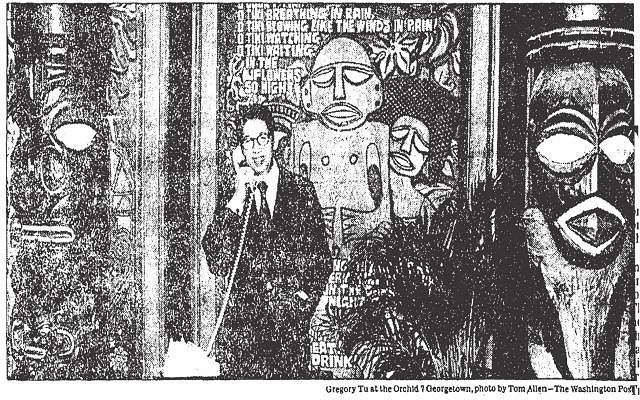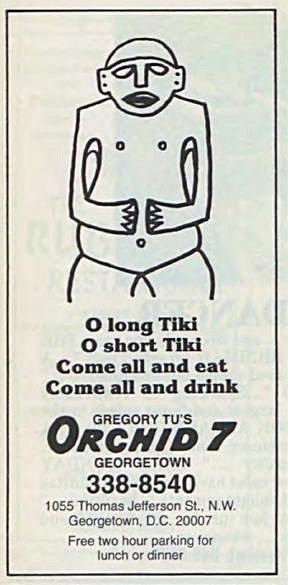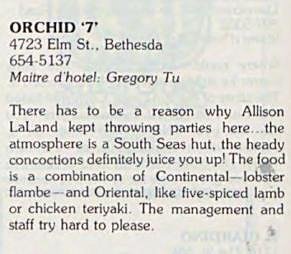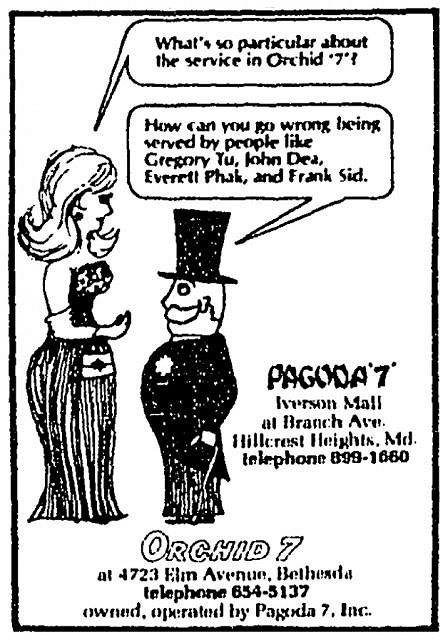so mix up a mai tai, read, and enjoy... until things get FONKY
The Polynesian Pattern
By William Rice
The Washington Post Jul 31, 1977;
What does it take to open a Polynesian restaurant these days? Courage and money! At least that's what one deduces after talking with Gregory Tu, who opened the ambitious Orchid 7 Georgetown this past week.
It took over a year of planning and more than $600,000 to design, decorate and staff the new, 200-seat restaurant located in the Foundry Building on Thomas Jefferson Street. "To do Polynesian decor right costs more, not less, than to decorate a conventional restaurant," Tu said. "Bamboo and rattan are difficult to work with, so the contractor had to hire an expert from Trinidad. We have hand-painted tapa cloth from four different island areas. Even the molding is hand-carved special wood."
Could it have been done for less? "It never even came to my mind to try to do this on the cheap," replied Tu with some astonishment.
He is a veteran restaurant man who helped open the Washington Trader Vic's in 1961 and stayed on to manage it for a decade before going his own way five years ago. A lunch during the final hectic days before opening found him making telephone calls to a printer to make final wording changes in the menu and worrying about "over-engineered banquettes" that were uncomfortable to sit on.
"They came out too far and were hard on the back," he said, "so we've moved the seat portion out two inches and up 3/4-inch to balance it out." To complete a recipe for a large headache, add to that an outsized carpet, tiles that were in Indianapolis instead of Washington, chairs that were still at sea on the voyage from Taiwan, a stove that had the gas jets on the wrong side - a minor problem, except it would totally distort the pattern waiters were meant to follow in picking up food from the cooks - and a myriad of details.
"Our only goal now is to get open on time," Tu said. (About 1,000 invitations had been sent out for a pre-opening party. It was held, on schedule, Tuesday evening.) "You can only decide approximately when you will open. Summer isn't supposed to be a good time. We had hoped for spring, but there were delays to overcome. You can't afford to wait for a proper time. When it's ready you have to start generating income."
In the restaurant business of today, you have to generate a lot of income. Tu estimated it will take a gross of $1,250,000 or more for Orchid 7 to be profitable. "Today it is not that difficult," he said, sipping on the iced tea that is at hand whenever he takes time to sit down. "Easily two dozen restaurants in Washington do it."
Orchid 7 will be open seven days a week and has a long-term lease with parking rights below the building and in a lot across the street, considered a major factor in congested Georgetown. Tu hopes to attract Kennedy Center patrons with a special post-theater menu featuring light fare and plans to grab a share of the increasing luncheon business in the area by offering selections guaranteed to be served in 14 or 29 minutes. As an aid to either cautions or eager drinkers, he is listing the spirits content ("S.C.") of the elaborate drinks the bartenders concoct.
Comparisons with Trader Vic's, still doing a lively business at the Capital Hilton, are inevitable. Several of Tu's key associates trained in the organization, and James Chen, executive chef of the local Trader Vic's until recently, has taken the same position with Orchid 7.
Tu, who is an outspoken admirer of Vic Bergeron, the man who built the Trader Vic's chain, granted that he has utilized much of what he learned in the organization. "We are smaller, though," he said, "so we can react more immediately to the tastes of our customers. We can do some dishes they can't. I think our style is more relaxed." He paused and smiled. "And our prices are lower."
"Also," he said, "I think we have transferred the Polynesian image from the food to the decor. Some of our food is from the islands, but the menu is a cross-section from Asian or European origin depending on its appeal."
The new Orchid 7 is the third local restaurant venture for Tu and his associates. The collaboration began in the mid 1960s when a group of Trader Vic staff members formed a savings club and pooled weekly donations to buy stocks. They "made some money" and when, through departures or marriages, their number dwindled to six they invested in a restaurant, the Pagoda 7, and one of their band, John Dea, became the manager.
"That was something," Tu recalled. "It was 1969 and I spent 2 1/2 days decorating the place myself. It had been Italian and we were two months without a wok to cook in."
Tu himself continued at Trader Vic's. A native of China, he had come to the United States in 1950 and took a degree in geology at the University of Southern California. After an unsuccessful and financially draining search for uranium, he went to work at the Los Angeles Trader Vic's when it opened in 1953. "I was a bus boy for 11 days and a waiter for 27 days," he said with pride. "I just worked my way up and came to Washington when we opened here."
Motivated by the "ambition to have something of my own," he departed for Bethesda to open the first Orchid 7 with his associates in 1972 on the site of a failed restaurant called the Orchid Isle on Oak Street off Wisconsin Avenue. The cost, which appears modest in retrospect, was $180,000. The architect was Dirk Kim, a former waiter who had moved to the West Coast. Kim repeated his assignment for the new restaurant.
"For three months business was so inconsistent I would send a waiter out to wave at cars and give him a dime for each party he attracted. No one comes there by accident. But gradually old friends from Trader Vic's, some diplomats and people from Congress came and put us on the map."
From the first there was talk of further expansion. A plan to build in Alexandria fell through, so did negotiations with the Shoreham Hotel. The offer from Inland Steel came in February, 1976, and Tu took the lease with him on a long-anticipated visit to his family in China. "It was a strange feeling, he said, "sitting on a hilltop in China meditating about opening a restaurant in Georgetown."
He did it, he said, because he "missed the action in downtown Washington," because he liked the location and the building itself and because, "as an old geologist, I believe that the place to strike oil is where there is oil and for a restaurant man there is a lot of oil in Georgetown.
"A lot of old friends will come and we will attract a lot of young couples, too. They both work and when they go out they like to be well treated. My idea is that people want dinner to be an event. They want a place to relax in and to enjoy themselves. So we give them lots of service. On this earth everybody is serving somebody and I think taking care of people's needs is what makes a good restaurant."
p.s. from what we can figure from the panel in the photo's background...
(sabina, is that the panel you saw at oceanic arts?) it says:













